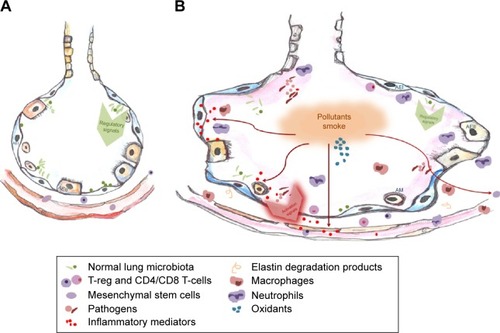Figures & data
Figure 1 Mechanisms underlying COPD development.
Notes: (A) The airway epithelium consisting of several diverse cell types maintains a balanced interaction with normal lung microbiota, and only regulatory signals are induced. Progenitors (mesenchymal stem cells) are recruited from circulation when needed. (B) Pathogenic bacteria (eg, Streptococcus pneumoniae, Pseudomonas aeruginosa) activate proinflammatory signaling pathways in the epithelium and also release chemokines and cytokines themselves. In parallel to air pollutants, cigarette smoke, oxidants also induce similar changes (fine red arrows). Air pollutants, including cigarette smoke, are a rich source of oxidants capable to recruit macrophages and neutrophils. Pollution also decreases a pool of progenitor cells in the circulation and locally (fine red arrow). Inflammatory cells (eg, neutrophils, dendritic cells, monocytes/macrophages, cytotoxic T-cells) arrive at the sites of inflammation and become the additional source of cytokines, oxidants, and proteases. CD4 and CD8 T-cells (Tc1/Th1-dominant) are present and release chemokines and perforins. At the same time, representatives of normal microbiota induce relatively weak signals to prevent the exaggeration of the inflammation. These stimuli-induced processes result in alveolar wall cells and vascular endothelial cells apoptosis/loss, and extracellular matrix proteolysis. Inflammation might be further triggered by elastin fragments. Structural alveolar disintegration, loss of epithelium and endothelium, and the overall inflammatory ambience are seen.
Abbreviations: AEI and AEII, alveolar type I and II epithelial cells; AM, alveolar macrophages; EC, endothelial cells.
Abbreviations: AEI and AEII, alveolar type I and II epithelial cells; AM, alveolar macrophages; EC, endothelial cells.

